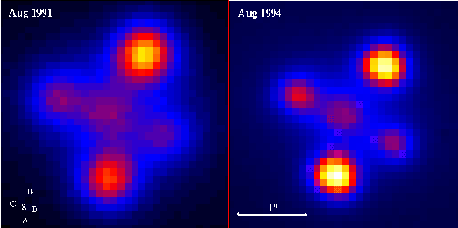Credit & Copyright: Geraint Lewis and Michael Irwin, William Hershel Telescope
Explanation:
The famous "Einstein Cross" is a case where a single object is seen four times.
Here a very distant
QSO
happened to be placed right behind a massive galaxy.
The gravitational effect of the galaxy on the distant QSO was similar to the
lens effect of a drinking glass on a distant street light - it created
multiple images. But stars in the foreground galaxy have been found to
act as gravitational lenses here too! These stars make the images
change brightness relative to each other. These brightness changes
are visible on these two photographs of the Einstein Cross, taken
about 3 years apart.
For more information about this picture see the home page of the IAU Symposium 173 Astrophysical Applications of Gravitational Lensing in Melbourne, Australia 9-14 July, 1995.
1999 2000 2001 2002 2003 2004 2005 2006 2007 2008 2009 2010 2011 2012 2013 2014 2015 2016 2017 2018 2019 2020 2021 2022 2023 2024 2025 |
Yanvar' Fevral' Mart Aprel' Mai Iyun' Iyul' Avgust Sentyabr' Oktyabr' Noyabr' Dekabr' |
NASA Web Site Statements, Warnings, and Disclaimers
NASA Official: Jay Norris. Specific rights apply.
A service of: LHEA at NASA / GSFC
& Michigan Tech. U.
|
Publikacii s klyuchevymi slovami:
Krest Einshteina - Mikrolinzirovanie - microlensing - Einstein cross
Publikacii so slovami: Krest Einshteina - Mikrolinzirovanie - microlensing - Einstein cross | |
Sm. takzhe:
Vse publikacii na tu zhe temu >> | |
